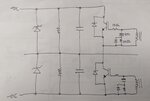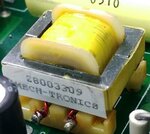Anna Conda
Banned
Was hoping you might show us the actual circuit to help in finding the faults in your design....?
Actually the UC3706 is a pretty poor choice of transformer driver given its high V drop when driving and holding low, you need a discrete circuit or a driver with a mosfet o/p stage to get a really low impedance drive (@ VHF) to the GD Tx, else you will get dV/dT induced turn on in the "other" device which will cause shoot thru losses, lots of RFI and overheating....!
Actually the UC3706 is a pretty poor choice of transformer driver given its high V drop when driving and holding low, you need a discrete circuit or a driver with a mosfet o/p stage to get a really low impedance drive (@ VHF) to the GD Tx, else you will get dV/dT induced turn on in the "other" device which will cause shoot thru losses, lots of RFI and overheating....!




